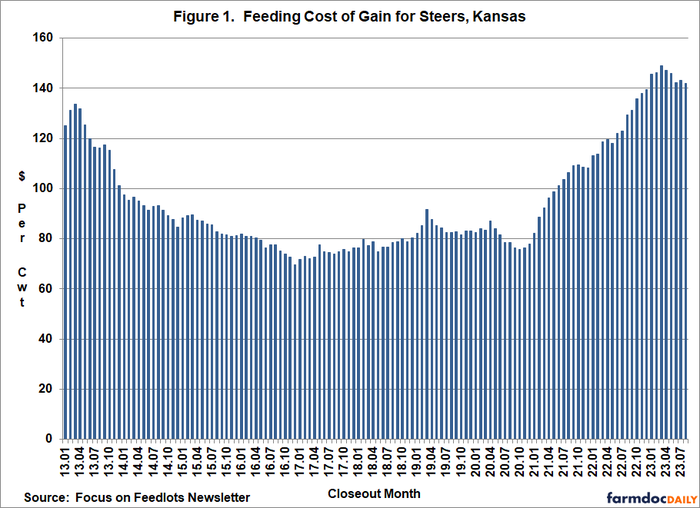Lower corn prices to benefit cattle feeding cost of gain
Corn prices have steadily fallen since the beginning of the year.

Corn prices have fallen since the beginning of the year and are expected to remain lower than levels experienced in the last couple of years for the foreseeable future, according to Michael Langemeier, agriculture economist at Purdue University. This, he suggests, will benefit feeding cost of gain for cattle finishing.
Langemeir relays that cash corn prices in Kansas were over $7.00/bushel in the first four months of 2023 but have since fallen. The most recent price data from the USDA showed the average corn price in August was $5.70/bu., or 22% lower than the price in February. Corn futures prices for 2024 currently range from $5.00-$5.20/bushel.
Feeding cost of gain
Langemeir says feeding cost of gain is sensitive to changes in feed conversions, corn prices, and alfalfa prices. Kansas State University Extension’s latest Focus on Feedlots newsletter covered feeding cost of gain from January 2013 to August 2023 (Figure). In August 2023, corn and alfalfa inventory prices were $7.04/bu. and $273.00/ton, respectively. After averaging $125.00/cwt. in 2022, Langemeir notes that feeding cost of gain averaged $147.00 and $145.00/cwt. for the first and second quarters of 2023. Feeding cost of gain in August was $141.83. Since then, he says corn prices have continued to fall.

Feeding cost of gain for the rest of 2023 was estimated using early October projections of corn and alfalfa prices, and seasonal average feed conversions.
“Because feeding cost of gain is computed using corn prices from the time cattle are placed to the time they are sold, corn prices experienced earlier this year will impact feeding cost of gain for the next several months,” Langemeir explains. “With this in mind, feeding cost of gain for the third quarter of 2023 is expected to range from $134.00-$143.00/cwt., with the highest cost occurring in July.”
Feeding cost of gain in Q4 2023 is expected to range from $115.00-$130.00/cwt., and feeding cost of gain for the first six months of 2024 is expected to range from $103.00-$112.00/cwt.
“Is it possible for feeding cost of gain to drop below $100.00/cwt.? The answer is yes, but this is not likely to occur unless corn price this fall and winter drops below $4.50/bushel.”
To determine the sensitivity of feeding cost of gain to changes in corn prices, alfalfa prices, and feed conversion, a regression using data for the last ten years was estimated. Langemeir’s results are as follows: each 10-cent increase in feed conversion increases feeding cost of gain by $1.33/cwt., each 10 cent/bushel increase in corn prices increases feeding cost of gain by 96 cents/cwt., and each $5.00/ton increase in alfalfa prices increases feeding cost of gain by 53 cents/cwt.
Because each 10-cent change in corn price results in a change feeding cost of gain of 96 cents/cwt., Langemeir says it is important to understand that it would not take a particularly wide swing in corn prices to change current projections.
About the Author(s)
You May Also Like




.png?width=300&auto=webp&quality=80&disable=upscale)
